Automotive lighting research: the penetration of ambient lights has reached 31%, and intelligent lighting is reshaping the third living space.
Favorable policies and consumption upgrade help automakers reshape their vehicles, a third living space in which technology, intelligence, comfort and emotion are the main themes. Automotive intelligent lighting components such as intelligent headlights and ambient lights will better meet the personalized needs of consumers. Intelligent and emotional automotive lighting systems open up a new space for vehicle intelligence.
Automotive lighting intelligence is not only reflected in the upgrade of people-vehicle interaction enabled by headlights and taillights, but also in the rapider penetration of automotive ambient lights and the intelligence of interior lighting for delivering better driving experience. This report aims to analyze the development trends of automotive lighting intelligence in China through introducing the intelligence routes of major automotive lighting manufacturers and the features of intelligent lighting systems for key vehicle models of OEMs.
China’s automotive lighting market was worth RMB60.45 billion in 2021, jumping by 15.2% year on year. As the pace of automotive lighting intelligence accelerates and the value of intelligent lighting per vehicle rises, we predict that China’s automotive lighting market will be valued up to RMB80.9 billion in 2024.

Global market: Chinese lighting companies have a long way to go overseas
In the global auto parts industry, automotive lighting is a highly concentrated segment. Leading manufacturers in Europe, America and Japan dominate the market. In 2021, two Chinese companies, HASCO Vision (a holding subsidiary of SAIC Group) and Changzhou Xingyu Automotive Lighting Systems edged into the club of leading global automotive lighting manufacturers. HASCO Vision grew out of nothing from 2016 to 2021 (Shanghai Koito Automotive Lamp Co., Ltd., a joint venture established by Shanghai Automotive Lamp Factory under SAIC and Japan's Koito. HASCO bought the shares of the company held by Koito in 2018. The company was then renamed HASCO Vision as a holding subsidiary of SAIC Motor); Xingyu's revenue multiplied by 126% during the same period. Yet in 2021 more than 90% of the revenues of the two companies came from the Chinese market, and foreign markets otherwise contributed low revenues, indicating that Chinese lighting companies still have a long way to go abroad.
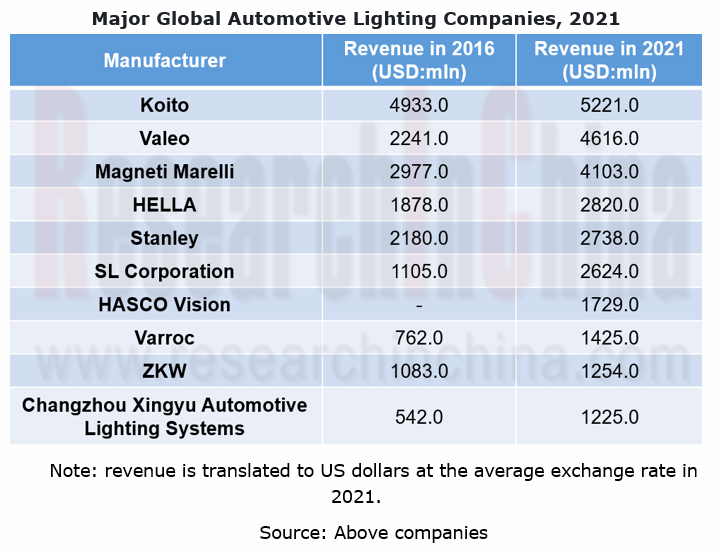
As with the global market, much of China’s automotive lighting market is still commanded by a few industry bellwethers, with the total market share of the top four players exceeding 50%. The difference is that in the Chinese market, HASCO Vision and Changzhou Xingyu Automotive Lighting Systems are respectively positioned first and second, and of the top ten manufacturers, four are Chinese companies, taking a combined share of about 38%.
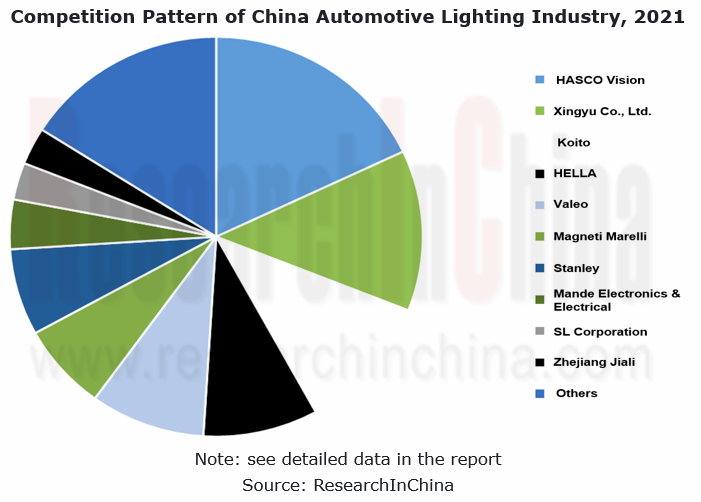
Lighting manufacturers: automotive lighting evolves from static shaping to dynamic interaction.
The rise of intelligent vehicles is a technological innovation booster to automotive lighting manufacturers. Multiple technology routes enable the evolution of automotive lighting from static shaping to dynamic interaction, allowing ordinary consumers to experience lighting systems that were once reserved for conventional high-end vehicle models.
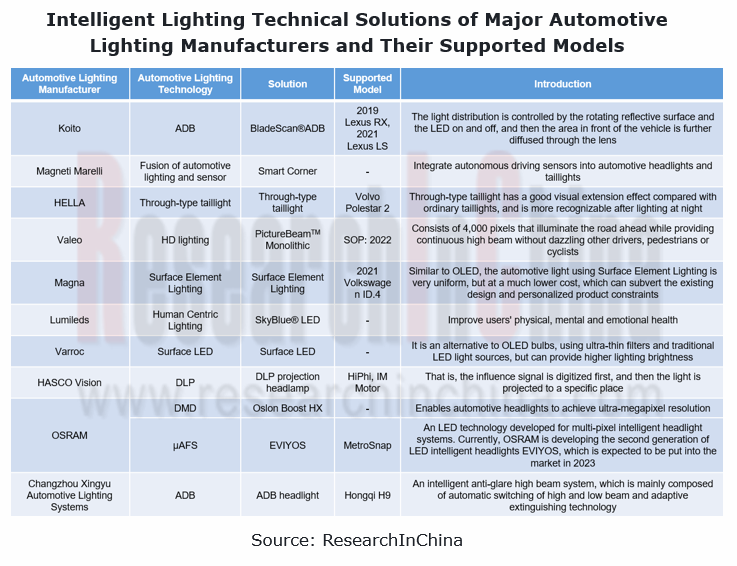
Koito BladeScan?ADB system
The system uses a pair of fast-revolving blade mirrors to change the shape and depth of the beam. Each headlight has 10 LEDs contained in the compact modules at the corners of the joints. The light from the system-controlled LEDs all pass through the mirror blades, the light is then continuously reflected out, and the light distribution is precisely controlled by synchronizing the rotation of the mirror blades and turning on/off the headlight LEDs. BladeScanTM ADB ensures high-resolution light distribution equivalent to the use of 300 LEDs and minimizes the shading area to maximize the lighting area.
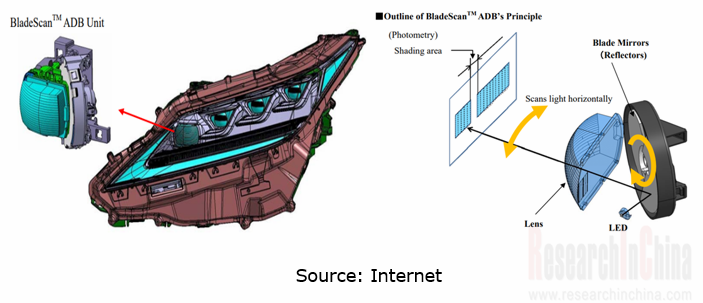
HELLA rear combination lamp concept: FlatLight
HELLA presented an innovative light guide concept based on micro-optics in early 2021. It enables particularly homogeneously illuminated surfaces with an extremely low module depth of only 5 millimeters. The technology will change the known functional characteristics of signal lights, and implement indicator, brake and tail light in just one optical element. The FlatLight concept requires about 80% less energy compared to conventional LED taillights.
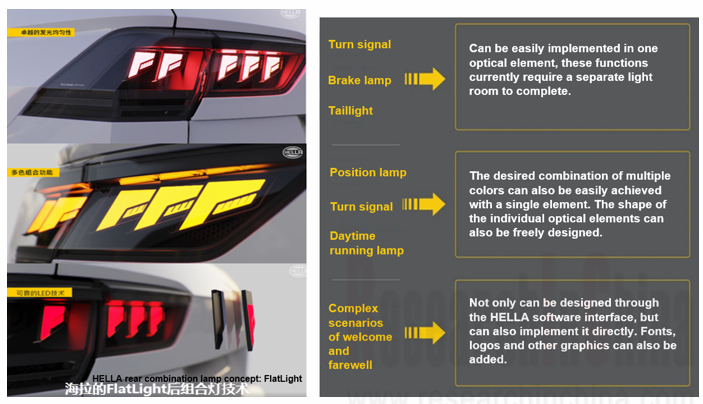
OEMs: the cooperation + self-development dual approach sets the trend for intelligence.
To meet consumers' needs for automotive lighting systems, OEMs enhance automotive lighting intelligence by way of working with lighting manufacturers and independently developing, a dual approach setting the trend for automotive lighting.
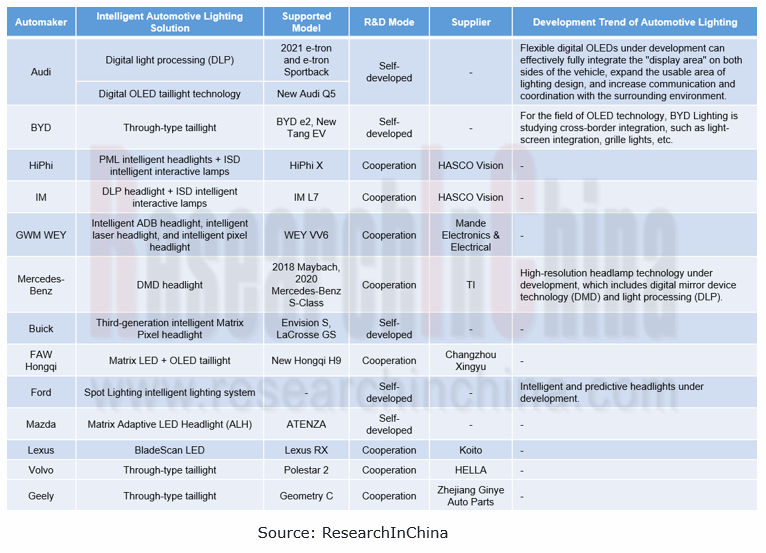
Digital Matrix Headlights for 2022 Audi A8
The new 2022 Audi A8 offers technical upgrades on the headlights. The digital matrix LED headlights use digital micro-mirror device (DMD) technology, similar to video projectors. Each headlight comprises some 1.3 million micromirrors that refract the rays into tiny pixels, thus ensuring high-precision light control. This headlight system also illuminates the driver’s lane in especially bright light, ensuring no departure from the lane. When unlocking and exiting the car, the digital Matrix LED headlights can cast projections onto floors or walls. This is known as the dynamic coming home/leaving home animations.
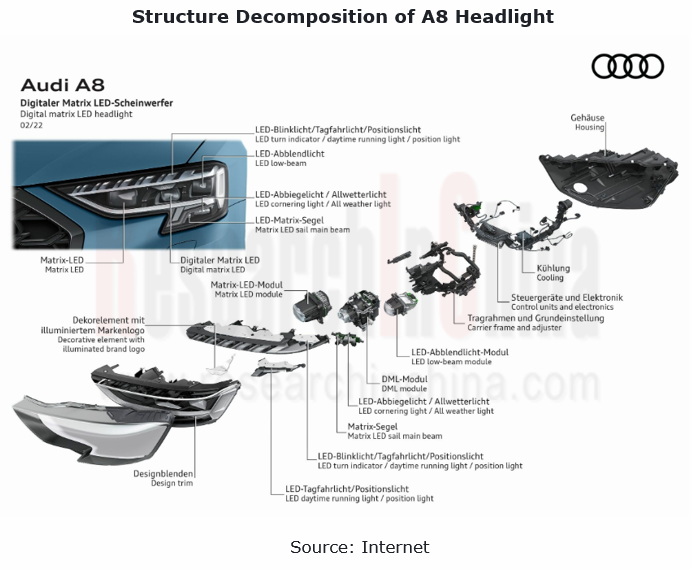

IM Motors’ intelligent lighting system
IM L7 carries HASCO Visio’s intelligent lighting system composed of second-generation 2.6MP DLP and 5,000 LED ISCs. The intelligent interactive signal light system consisting of 5,000 LEDs makes the car a large interactive screen, displaying user-defined information on the rear interactive screen.
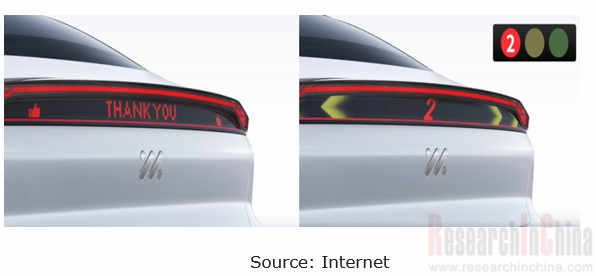
The 2.6MP DLP headlights can project clear guidance signs onto the road in navigation mode, so that the driver can more intuitively know where the car goes. When driving at night, the light moves with the driver's line of sight, bringing a clearer view.

Intelligent interactive lighting system for HiPhi X
Developed by HASCO Vision, the system is comprised of PML intelligent headlights and ISD intelligent interactive combination lights. It can perceive the road environment and make decisions on its own, thus realizing all-scenario adaptive lighting and intelligent tracking and interaction with external people and vehicles. The ISD lights are deployed at the front fog lamps and the area below the taillights. The main body of the ISD intelligent interactive lights is four LED matrix panels with 1,712 LED light sources.
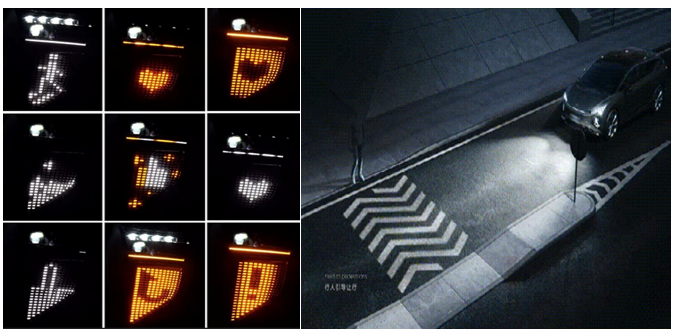
The PML headlight includes 2.6 million independently controllable nanoscale micro-reflectors that deliver stepless deflection every +/-12°. It also bears an infrared night vision camera, an independent customized ECU chip and an intelligent computing platform to ensure computing capacity and speed, judge road conditions, calculate distance, and output images. The PML intelligent headlight allows intelligent light pattern adjustment with speed and can automatically switch 4 driving lighting modes (standard low beam, urban high beam, standard high beam, and centralized high beam). In addition, it can also intelligently recognize driving scenarios and enable 6 intelligent lighting functions (vehicle tracking in obscuration, driving trajectory prediction, lane departure warning, blind-spot lane change warning, low-speed steering assistance, and active horizontal adjustment).

Ambient light: with a penetration up to 31%, it is a promising market.
Before 2017, except luxury models of Mercedes-Benz, BMW and Audi which were directly pre-installed with ambient lights, other models packed this function in the aftermarket. Yet since the second half of 2017, OEMs have begun to equip their mid-end models with ambient lights. In 2021, the penetration of ambient lights hit 31%. From the models with ambient lights as a standard configuration in 2021, it can be seen that 36% of them carried monochrome ambient lights, and the 64-color, 7-color, and 11-color followed, accounting for 13%, 8%, and 6%, respectively.
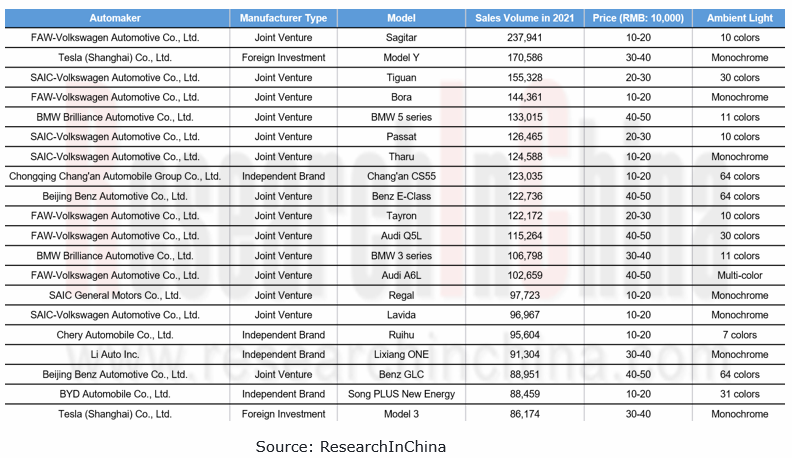
As OEMs are committed to building cars into a third space other than home and workplace and make continuous efforts to improve the intelligence and comfort levels of cars, the penetration of ambient lights will go higher in the future.
Passenger Car Cockpit Entertainment Research Report, 2023
Cockpit entertainment research: vehicle games will be the next hotspot.
The Passenger Car Cockpit Entertainment Research Report, 2023 released by ResearchInChina combs through the cockpit entertainme...
Smart Road - Roadside Perception Industry Report, 2023
Roadside perception research: evolution to integration, high performance and cost control.In June 2023, at a regular policy briefing of the State Council the Ministry of Industry and Information Techn...
China Passenger Car ADAS Domain Controller,Master Chip Market Data and Supplier Research Report, 2023Q1
Quarterly Report on ADAS Domain Controllers: L2+ and above ADAS Domain Controller Master Chip Market Structure This report highlights the passenger car L2+ and above (including L2+, ...
Automotive Cockpit Domain Controller Research Report, 2023
Research on cockpit domain controllers: various forms of products are mass-produced and mounted on vehicles, and product iteration speeds up.
Both quality and quantity have been improved, and the it...
Chinese Passenger Car OEMs’ Overseas Layout Research Report, 2023
OEMs’ overseas layout research: automobile exports are expected to hit 7.18 million units in 2025.
1. China’s automobile export market bucked the trend.
During 2021-2022, the global economy ...
Global and Chinese Automakers’ Modular Platform and Technology Planning Research Report, 2023
Research on modular platforms: explore intelligent evolution strategy of automakers after modular platforms become widespread.
By analyzing the planning of international automakers, Chinese conventi...
China Passenger Car Mobile Phone Wireless Charging Research Report, 2023
Automotive Wireless Charging Research: high-power charging solutions will lead the trend, with the installations to hit more than 10 million units in 2026.
Technology Trend: Qi2 Standard
The automo...
NXP’s Intelligence Business Analysis Report, 2022-2023
In 2015, NXP acquired Freescale for USD11.8 billion, hereby becoming the largest automotive semiconductor vendor. Yet NXP's development progress has not always gone smoothly. In 2021, Infineon replace...
Bosch’s Intelligent Cockpit Business Analysis Report, 2022-2023
Despite the chip shortage and the sluggish economy, Bosch’s sales from all business divisions bucked the trend in 2022. Wherein, the Mobility Solutions, still the company’s biggest division, sold EUR5...
Analysis on Baidu’s Intelligent Driving Business, 2022-2023
Baidu works on three autonomous driving development routes: Apollo Platform, Apollo Go (autonomous driving mobility service platform) and intelligent driving solutions. &n...
Ambarella’s Intelligent Driving Business Analysis Report, 2022-2023
Ambarella was founded in 2004 and is headquartered in California, the US. Before 2014, Ambarella was the exclusive chip supplier of GoPro. Ambarella was listed on NASDAQ in 2012. When the sports camer...
Global and China Electronic Rearview Mirror Industry Report, 2023
Electronic rearview mirror research: 2023 will be the first year of mass production as the policy takes effect
Global and China Electronic Rearview Mirror Industry Report, 2023 released by ResearchIn...
China Autonomous Driving Domain Controller Research Report, 2023
Autonomous driving domain controller research: explore computing power distribution and evolution strategies for driving-parking integrated domain controllers.
In China, at this stage the industry i...
China In-Vehicle Payment Market Research Report, 2023
China In-Vehicle Payment Market Research Report, 2023 released by ResearchInChina analyzes and researches the status quo of China's in-vehicle payment market, components of the industry chain, layout ...
ADAS and Autonomous Driving Tier 1 Suppliers Research Report, 2023 – Chinese Companies
Research on China’s local Tier 1 suppliers: build up software and hardware strength, and “besiege” driving-parking integration by three routes. 01 Build up their own software and hardware capabilities...
Leading Tier1 Suppliers’ Intelligent Cockpit Business Research Report, 2023 (Foreign Players)
Research on tier 1 suppliers’ cockpit business: new innovative intelligent cockpit products highlight multi-domain integration, multimodal interaction, and ever higher functional integration.
Follow...
Leading Tier1 Suppliers’ Intelligent Cockpit Business Research Report,2023 (Chinese Players)
Research on tier 1 suppliers’ cockpit business: new innovative intelligent cockpit products highlight multi-domain integration, multimodal interaction, and ever higher functional integration.
Follow...
Company Analysis: Jingwei Hirain’s Automotive and Intelligent Driving Business, 2022-2023
Founded in 2003, Jingwei Hirain Technologies is headquartered in Beijing, with modern production facilities in Tianjin and Nantong. In 2022, Jingwei Hirain Technologies recorded revenue of RMB4,021 mi...